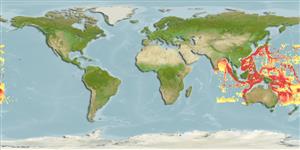>
Pleuronectiformes (Flatfishes) >
Bothidae (Lefteye flounders)
Etymology: Kamoharaia: Because of T. Kamoharai, Japanese contemporary ichthyologist.
Environment: milieu / climate zone / depth range / distribution range
Ecologia
marinhas batidemersal. Deep-water
Western Pacific: southern Japan and Taiwan to the Indo-Australian Archipelago (including western Australia).
Tamanho / Peso / Idade
Maturity: Lm ? range ? - ? cm
Max length : 22.5 cm TL macho/indeterminado; (Ref. 3131)
Espinhos dorsais (total): 0; Raios dorsais (total): 109-112; Espinhos anais 0; Raios anais : 84 - 86. Mouth extremely large, maxillary strongly protruding beyond the tip of the snout anteriorly, and extending far beyond lower eye posteriorly. Upper jaw with 3 to 4 pairs of larger teeth anteriorly, and lower jaw with 3 pairs of curved strong canines anteriorly. Pectoral fin dark.
Inhabits sand and mud bottoms at depths of about 800 m (Ref. 9824). Rarely caught with bottom trawls (Ref. 9824).
Ciclo de vida ou comportamento de acasalamento
Maturidade | Reprodução | Desova | Ovos | Fecundidade | Larvas
Sainsbury, K.J., P.J. Kailola and G.G. Leyland, 1985. Continental shelf fishes of the northern and north-western Australia. An illustrated guide. CSIRO Division of Fisheries Research; Clouston & Hall and Peter Pownall Fisheries Information Service, Canberra, Australia. 375 p. (Ref. 3131)
Status na Lista Vermelha da UICN (Ref. 130435)
Ameaça para os humanos
Harmless
Uso pelos humanos
Pescarias: sem interesse
Mais informação
Nomes comunsSinônimosMetabolismoPredadoresEcotoxicologiaReproduçãoMaturidadeDesovaAgregação de desovaFecundidadeOvosDesenvolvimento dos ovos
ReferênciasAquaculturaPerfil para aquaculturaEstirpesGenéticaElectrophoresesHereditariedadeDoençasProcessamentoNutrientsConversão de massa
Ferramentas
Relatórios especiais
Baixar XML
Fontes da internet
Estimates based on models
Preferred temperature (Ref.
123201): 2.6 - 6.2, mean 3.9 °C (based on 979 cells).
Índice de diversidade filogenética (Ref.
82804): PD
50 = 1.0000 [Uniqueness, from 0.5 = low to 2.0 = high].
Bayesian length-weight: a=0.00912 (0.00408 - 0.02036), b=3.05 (2.87 - 3.23), in cm total length, based on LWR estimates for this (Sub)family-body shape (Ref.
93245).
Nível Trófico (Ref.
69278): 3.6 ±0.4 se; based on size and trophs of closest relatives
Resiliência (Ref.
120179): médio(a), tempo mínimo de duplicação da população 1,4 - 4,4 anos (Assuming tmax>3).
Fishing Vulnerability (Ref.
59153): Low vulnerability (13 of 100).
